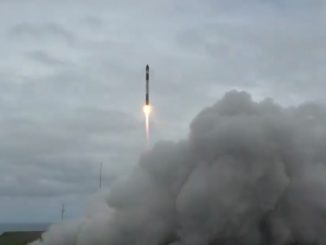
Rocket Lab launched its ninth mission of 2024 and its 51st Electron rocket launch to date. The flight sent an Earth observing satellite to low Earth orbit on behalf of Japan-based Synspective.
Liftoff of the “Owl for One, Owl for All” mission from Launch Complex 1’s Pad B in Mahia, New Zealand happened Saturday, Aug. 3, at 4:39 a.m. NZT (Friday, Aug. 2, at 12:39 p.m. EDT, 1639 UTC).
The launch was the fifth of 16 planned launches for Synspective and its constellation of synthetic aperture radar (SAR) satellites. These are “designed to deliver imagery that can detect millimeter-level changes to the Earth’s surface from space.”
“In addition to deploying the single StriX satellite to space for this mission, Rocket Lab will perform an advanced mid-mission maneuver with Electron’s Kick Stage to shield the satellite from the sun and reduce radiation exposure,” Rocket Lab wrote on its website prior to liftoff.
The first of these satellites launched on Dec. 15, 2020, with two more launching in 2022. The “Owl Night Long” mission was the first of three planned launches for Synspective in 2024. Rocket Lab has one more launch for Synspective on its manifest this year.
The Saturday launch, locally, features a custom-designed payload fairing. Rocket Lab noted on X, formerly Twitter, that it “was made specifically for the wide body of Synspective’s StriX satellite and is one of the many ways we can tailor our dedicated launches for our customers.”
Turn it up. pic.twitter.com/BEcw94jWdv
— Peter Beck (@Peter_J_Beck) August 2, 2024
End-to-end space company
In addition to its Electron rocket launches, Rocket Lab continues to be quite busy with a number of other ventures around the world. The test campaign for the company’s Archimedes engines is ongoing at NASA’s Stennis Space Center in Mississippi.
These will power the Neutron rocket, which is set to debut in 2025.
“It’s super exciting seeing all the hardware come together and, you know, it feels a little bit like old Electron days,” Beck said in an interview with Spaceflight Now in June. “The same kind of tests and apprehensions of the tests and all those kinds of things, getting to do all over again.
“I’d say the good news is that, it feels like deja vu because we’ve done this before and we know how to do it as opposed to a new team learning to do it for the first time. So, that gives us a large degree of confidence that we can get this thing on the pad, middle of next year, but I always caution everybody that it’s a rocket program.”
Meanwhile, they are also preparing for missions on the Moon and in orbit around Mars. It created the guidance, navigation and control (GNC) as well as flight software that will be used on Firefly Aerospace’s Blue Ghost lunar lander, which aims to launch in late 2024.
It also is preparing to ship a pair of spacecraft to Florida that will perform NASA’s Escape and Plasma Acceleration and Dynamics Explorers (ESCAPADE) mission. The twin spacecraft, Blue and Gold, were designed “to study the interaction between the solar wind and Martian atmosphere,” according to Rocket Lab.
The duo are set to launch onboard the first New Glenn rocket from Blue Origin in fall 2024.



